|
|
 |
Fiche d'espèce de Copépode |
|
|
Calanoida ( Ordre ) |
|
|
|
Arietelloidea ( Superfamille ) |
|
|
|
Arietellidae ( Famille ) |
|
|
|
Arietellus ( Genre ) |
|
|
| |
Arietellus simplex Sars, 1905 (F,M) | |
| | | | | | | Syn.: | Arietellus major Esterly, 1906 a (p.74, figs.F); Sewell, 1948 (p.563); in CalCOFI regional list (MDO, Nov. 2013 ; M. Ohman, comm. pers.) | | | | Ref.: | | | Sars, 1905 c (p.22, Descr.F); Farran, 1908 b (p.82); A. Scott, 1909 (p.143, Rem.); Wolfenden, 1911 (p.331, figs.F, Rem.M); Sars, 1925 (p.334, figs.F, M); Sewell, 1932 (p.329); Jespersen, 1934 (p.116); 1940 (p.65); Lyshholm & al., 1945 (p.40); Sewell, 1947 (p.236); C.B. Wilson, 1950 (p.168, figs.F,M, F: anomalie); Brodsky, 1950 (1967) (p.395, figs.F,M); Vervoort, 1957 (p.141, Rem.); Tanaka, 1964 c (p.233, figs.F); Vervoort, 1965 (p.154, Rem.); Owre & Foyo, 1967 (p.90, figs.F,M); Moraïtou-Apostolopoulou, 1969 a (p.189); Razouls, 1994 (p.174, figs.F,M); Ohtsuka & al., 1994 (p.131, Rem.M, figs.M); Heinrich, 1996 (p.1784, figs.M); Chihara & Murano, 1997 (p.720, Pl.: 54: F,M); Bradford-Grieve & al., 1999 (p.882, 937, figs.F,M); Vives & Shmeleva, 2007 (p.153, figs.F,M) | 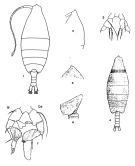 Female: 1, habitus (dorsal view); 2, Head (lateral); 3, P5; Issued from : Wolfenden R.N. in Dt. Südpol.-Exped., 1911, 12 (Zool. 4): 181-380. Male: 4, habitus (dorsal); 5, Head (lateral); 6, Th4+5 (lateral and 1st genital segment; 7, P5 (Dt: right, G: left); Issued from Scott A. in Siboga Exped., Monogr., 1909, 29a: 1-323.
|
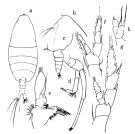 issued from : O. Tanaka in Publs Seto Mar. Biol. Lab., 1964, XII (3). [p.233, Fig.221]. Female (from Sagami, Japan): a, habitus (dorsal; b, foreheas (left lateral side); c, last thoracic segment and urosome (left lateral side); d, A2; e, Mx1; f, P1; g, P2; h, left P5. Nota: Cephalothorax 4.40 mm, abdomen 1.37 mm. Abdomen 4-segmented. The urosomal segments and caudal rami in the proportional lengths as 31 : 16 : 13 : 12 : 28 = 100. Genital segment about as long as wide, slightly produced below near the proximal ventral margin. Caudal rami about 2 times as long as wide. A1 extends to the end of the thoracic segment. A2 endopod 2 times as long as the exopod. Md without endopod; biting part simple in structure. Mx1 without 3rd inner lobe; endopod represented by a single strong seta. Mxp as that of A. setosus figured by Giesbrecht. Exopod of P5 1-segmented and endopod 1-segmented; endopod furnished with 2 setae of about equal lengths at the distal margin; seta on the 2nd basal segment of the right leg longer than that of the left.
|
 issued from : S. Ohtsuka, G.A. Boxshall & H.S.J. Roe in Bull. nat. Hist. Lond. (Zool.), 1994, 60 (2). [p.132, Fig.16, E,I]. Male (from Canary Is.): E, exopod of A2; I, endopod of Mx1. Scale bars in mm. Nota: exopod of A2 indistinctly 8-segmented (setal formula: 0, 1, 1, 1, 1, 0, 0, 3, respectively). 1st exopod segment of mandibular palp with normally developed seta. endopod of Mx1 represented by low knob, almost fused with basis (Fig.16, I)
|
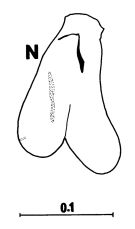 issued from : S. Ohtsuka, G.A. Boxshall & H.S.J. Roe in Bull. nat. Hist. Lond. (Zool.), 1994, 60 (2). [p.134, Fig.18,N]. Male: N, left endopod of P5. Scale bar in mm. Nota: left endopod of P5 indistinctly 2-segmented, suture visible on both surfaces; terminal and subterminal spines on 3rd exopod segment , terminal spine with 4 minute spinules terminally; terminal spine of distal compound exopod segment of right leg unarmed.
|
 issued from : A.K. Heinrich in Zool. Zh., 1996, 75 (12). [p.1783, Fig.6]. Female (from SW Indian Ocean): 1, habitus (dorsal); 2, forehead (lateral); 3, last thoracic segment and urosome (lateral right side); 4, urosome (ventral); 5, idem (lateral right side); 6, P5. Scale bars in mm.
|
 issued from : A.K. Heinrich in Zool. Zh., 1996, 75 (12). [p.1784, Fig.7]. Male: 1, habitus (dorsal); 2, forehead (lateral); 3, last thoracic segment and urosome (lateral right side); 4, P5; 5, left P5 (distal segment of exopodite). Scale bars in mm: 1.0 (1-4); 0.100 mm (5).
|
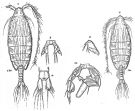 Issued from : G.O. Sars in Résult. Camp. Scient. Prince Albert I, 69, pls.1-127 (1924). [Pl.CXX, figs.7-12]. Female: 7, habitus (dorsal); 8, forehead (lateral); 9, P5; 10, anal segment and caudal rami (dorsal). Male: 11, habitus (dorsal); 12, P5.
|
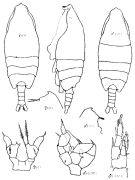 Issued from : K.A. Brodskii in Calanoida of the Far Eastern Seas and Polar Basin of the USSR. Opred. Fauna SSSR, 1950, 35 (Israel Program for Scientific Translations, Jerusalem, 1967) [p.396, Fig.281]. Female (from Sea of Okhotsk): habitus (dorsal and lateral left side); forehead (lateral); P5. Male (from NW Pacif.): habitus (dorsal); forehead (lateral); S1, P1; S5, P5.
|
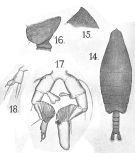 issued from : A. Scott in Siboga-Expedition, 1909, XIX a. [Plate XLIV, Figs.14-18]. Male (from Molucca Passage): 14, habitus (dorsal); 15, forehead (lateral); 16, last thoracic and genital segments (left side); 17, P5. Female (after Esterly, 1906): 18, P5.
|
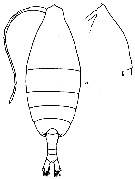 issued from : R.N. Wolfenden in Die Marinen Copepoden der Deutschen Südpolar-Expedition 1901-1903, 1911. [p.332, Fig.68]. Female (from tropical Atlantic): a, habitus (dorsal); b, forehead (lateral).
|
 issued from : R.N. Wolfenden in Die Marinen Copepoden der Deutschen Südpolar-Expedition 1901-1903, 1911. [Pl.XXXVI, Fig.5]. Female: 5, P5.
|
 issued from : C.O. Esterly in Univ. Calif. Publs Zool., 1906, 3 (5). [Pl.9, Fig, 17]. As Arietellus major. Female (from San Diego, California): 17, forehead (lateral).
|
 issued from : C.O. Esterly in Univ. Calif. Publs Zool., 1906, 3 (5). [Pl.11, Figs.43, 44]. As Arietellus major. Female: 43, last thoracic segment and urosome (lateral); 44, urosme (ventral).
|
 issued from : C.O. Esterly in Univ. Calif. Publs Zool., 1906, 3 (5). [Pl.12, Fig.56]. As Arietellus major. Female: 56, Md (mandibular blade).
|
 issued from : C.O. Esterly in Univ. Calif. Publs Zool., 1906, 3 (5). [Pl.13, Fig.80]. As Arietellus major. Female: 80, P5.
|
 issued from : C.B. Wilson in Bull. U.S. natn. Mus., 1950, 100 (14) (4). [Pl. 21, Fig.300]. Female : P5 (anomalous).
|
 Issued from : C. Razouls in Ann. Inst. océanogr., Paris, 1994, 70 (1). [p.174]. Caractéristiques morphologiques de Arietellus simplex femelle et mâle adultes. Terminologie et abbréviations: voir à Calanus propinquus.
| | | | | Ref. compl.: | | | Sewell, 1948 (p.330, 505, 522, 531, 539, 548, 559); Minoda, 1958 (p.253, 255: occurrence); De Decker & Mombeck, 1964 (p.11); Furuhashi, 1966 a (p.295, vertical distribution in Oyashio/Kuroshio transitional area, Table 8); Grice & Hulsemann, 1967 (p.19); 1968 (tab.2); Roe, 1972 (p.277, tabl.1, 2); Björnberg, 1973 (p.349, 386); Deevey & Brooks, 1977 (p.156, tab.2, Station "S"); Stephen & Rao, 1980 (p.242); Vives, 1982 (p.294); Madhupratap & Haridas, 1986 (p.105, tab.1); Lozano Soldevilla & al., 1988 (p.60); Hopkins & Torres, 1988 (tab.1); Razouls & al., 2000 (p.343, Appendix); Holmes, 2001 (p.14, Rem.); Hsiao & al., 2004 (p.325, tab.1: as Arietella simplex); Dur & al., 2007 (p.197, Table IV); Gaard & al., 2008 (p.59, Table 1, N Mid-Atlantic Ridge); Galbraith, 2009 (pers. comm.); Park & Ferrari, 2009 (p.143, Table 4, Appendix 1, biogeography) | | | | NZ: | 16 | | |
|
Carte de distribution de Arietellus simplex par zones géographiques
|
| | | | | | | | | | | |  issued from : R. Stephen & T.S.S. Rao in J. Plankton Res., 1980, 2 (2). [p.242, Fig.1]. issued from : R. Stephen & T.S.S. Rao in J. Plankton Res., 1980, 2 (2). [p.242, Fig.1].
Distribution of Arietellus and Paraugaptilus in the Indian Ocean (open circles indicate the stations selected for the study). |
| | | | Loc: | | | Antarct. (Peninsula, Weddell Sea, S Indian), South Africa (E), G. of Guinea, off NE St. Paul Is., Cape Verde Is., off Mauritania, Canary Is., off Madeira, Portugal, Azores, Caribbean Seas, Sargasso Sea, off Bermuda (Station "S"), off W Ireland, S Strait of Davis, S Iceland, ? Mediterranean Sea, Arabian Sea, Laccadive Is., S Madagascar, Indian, Indonesia-Malaysia, Philippines, China Seas (South China Sea), Taiwan, Japan (Izu region), Okhotsk Sea, Aleutian Is., Queen Charlotte Is., Vancouver Is., Pacif. (equatorial), California, NE Marquesas Is., SW Galapagos, E Easter Is., off Juan Fernandez Is., Chile (N & S) | | | | N: | 40 | | | | Lg.: | | | (1) F: 6,6; (5) M: 6,2; (10) F: 5,6; M: 5; (16) F: 5,7-4,75; M: 5,45-4,85; (17) F: 6,2; (25) F: 6,95; (71) M: 6,1; (120) F: 5,77; (199) F: 6-5,62; M: 6,08-5,24; (852) F: 5,6-5,75; M: 5,1; {F: 4,75-6,95; M: 4,85-6,20} | | | | Rem.: | bathy-abyssopélagique.
Sampling depth (Antarct.): 300-600-1000 m.
Voir aussi les remarques en anglais | | | Dernière mise à jour : 03/12/2020 | |
|
|
 Toute utilisation de ce site pour une publication sera mentionnée avec la référence suivante : Toute utilisation de ce site pour une publication sera mentionnée avec la référence suivante :
Razouls C., Desreumaux N., Kouwenberg J. et de Bovée F., 2005-2025. - Biodiversité des Copépodes planctoniques marins (morphologie, répartition géographique et données biologiques). Sorbonne Université, CNRS. Disponible sur http://copepodes.obs-banyuls.fr [Accédé le 29 novembre 2025] © copyright 2005-2025 Sorbonne Université, CNRS
|
|
 |
 |




















